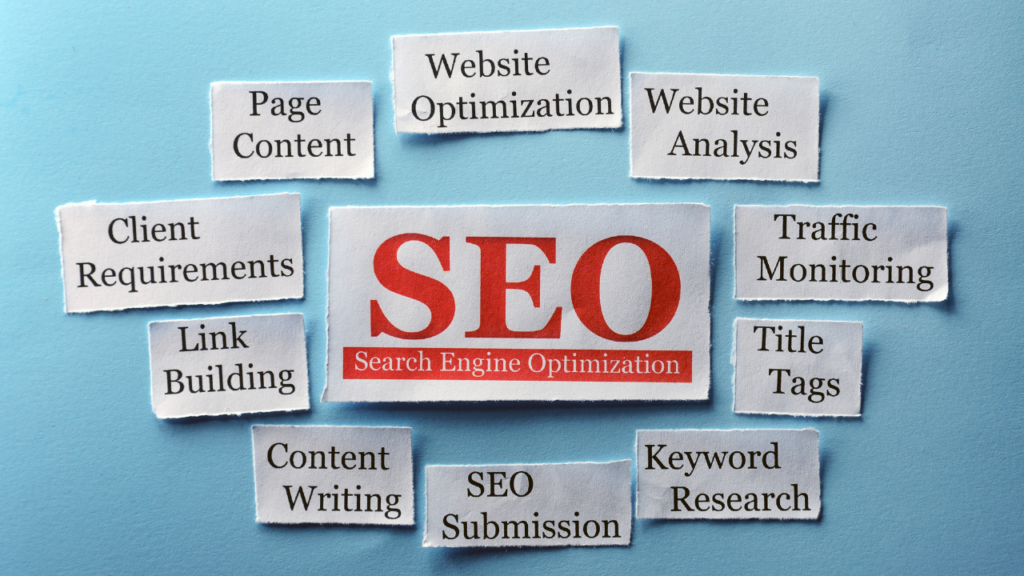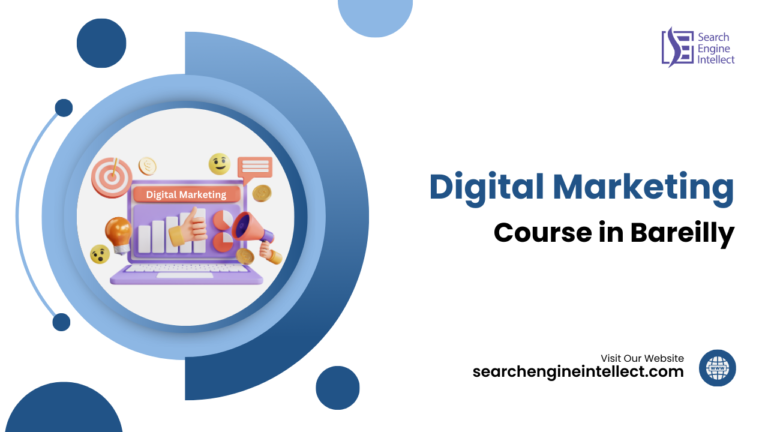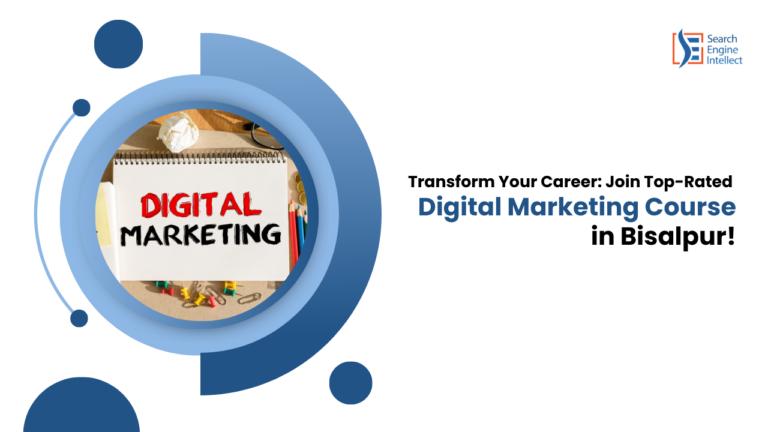Learn How to Create a Newspaper Website- From Concept to Launch
Creating a professional newspaper website can be daunting, especially with limited technical knowledge. Many face challenges in:-
- Difficulty in setting up a professional newspaper website
- Lack of technical knowledge for website development
- Challenges in designing a user-friendly layout
- Struggles with content management and SEO optimization
- Monetization issues
Fortunately, digital marketing courses in Bareilly offer step-by-step practical guidance on design, content management, SEO and Monetization strategies for your newspaper website to overcome these hurdles and build a successful online presence for your newspaper work.
Table of Contents
Understanding the Basics of a Newspaper Website
Definition and Importance
A newspaper website is the digital version of a traditional newspaper, providing news, features, and other information of public interest online. It can either be a stand-alone publication or the online counterpart of a printed newspaper. The importance of a newspaper website lies in its ability to deliver timely news and information to a global audience, leveraging the reach and immediacy of the internet.
Key Features of a Successful Newspaper Website
- User-Friendly Design:
- Responsive Layout: Ensures the website is accessible and visually appealing on all devices, including smartphones, tablets, and desktops.
- Easy Navigation: Clear menus and search functionality to help users find content quickly and easily.
- High-Quality Content:
- Timely News Updates: Regular updates on current events to keep readers informed.
- Diverse Content: Includes news articles, opinion pieces, multimedia content (videos, podcasts), and interactive features.
- SEO Optimization:
- Keyword Research: Use of relevant keywords to improve search engine rankings.
- Meta Tags and Descriptions: Properly optimized meta tags and descriptions to enhance visibility.
- Monetization Strategies:
- Advertising: Display ads, sponsored content, and affiliate marketing to generate revenue.
- Subscription Models: Paywalls and membership options for exclusive content access.
- Engagement Tools:
- Comment Sections: Allow readers to engage with content and share their opinions.
- Social Media Integration: Easy sharing options to promote content on social media platforms.
- Analytics and Performance Tracking:
- Web Analytics Tools: Use of tools like Google Analytics to monitor traffic, user behavior, and content performance.
By incorporating these features, a newspaper website can effectively serve its audience, maintain high engagement levels, and generate revenue through various monetization strategies.
Planning Your Newspaper Website
Identifying Your Target Audience
Understanding your target audience is crucial for the success of your newspaper website. Here are some steps to identify them:
- Examine Your Existing Customer Base:
- Analyze demographics, behaviors, and preferences of your current readers.
- Segment your audience based on these traits to tailor your content and marketing strategies effectively[2].
- Research Industry Trends:
- Stay updated with the latest trends in the news industry.
- Observe what competitors are doing and identify gaps you can fill[2].
- Create Buyer Personas:
- Develop detailed profiles of your ideal readers, including their age, location, interests, and reading habits.
- Use these personas to guide your content creation and marketing efforts[2].
Defining Your Niche and Content Strategy
Choosing a niche and developing a content strategy are vital steps in setting up your newspaper website:
- Identify Your Niche:
- Select a specific area of focus, such as local news, politics, sports, or entertainment.
- Ensure your niche has a substantial audience and potential for growth[4].
- Develop a Content Strategy:
- Plan the types of content you will publish, such as news articles, opinion pieces, multimedia content, and interactive features.
- Create a content calendar to schedule regular updates and maintain consistency[5].
- Set Content Guidelines:
- Establish editorial standards to ensure quality and consistency.
- Define the tone, style, and voice of your content to align with your brand identity.

Choosing a Domain Name and Hosting Service
Selecting the right domain name and hosting service is essential for your newspaper website’s success:
- Choosing a Domain Name:
- Pick a domain name that is memorable, easy to type, and reflects your brand.
- Use tools like Domain.com, Namecheap, or Bluehost to check availability and register your domain[6][8].
- Selecting a Hosting Service:
- Choose a reliable hosting provider that offers good uptime, fast loading speeds, and excellent customer support.
- Consider options like Hostinger for beginners, inMotion Hosting for tech-savvy users, or ScalaHosting for enterprise needs[7].
- Additional Considerations:
- Look for hosting services that offer additional features like SSL certificates, email hosting, and website builders.
- Ensure the hosting plan you choose can handle the expected traffic and content volume of your newspaper website[7][8].
By following these steps, you can effectively plan your newspaper website, ensuring it meets the needs of your target audience and stands out in your chosen niche.
Selecting the Right Platform
Choosing the right Content Management System (CMS) is crucial for building a successful newspaper website. Here is an overview of the three most popular CMS options—WordPress, Joomla, and Drupal—along with their pros and cons.
Overview of Popular CMS Options
WordPress
Overview:
WordPress is the most popular CMS, originally designed as a blogging platform but now capable of supporting various types of websites, including news sites.
Pros:
- Ease of Use: User-friendly interface, ideal for beginners.
- Extensive Plugin Library: Over 58,000 plugins for customization.
- Large Community: Strong support network with forums, tutorials, and documentation.
- SEO-Friendly: Built-in SEO tools and plugins like Yoast SEO.
Cons:
- Security: More vulnerable to security threats due to its popularity.
- Performance: Can be slower if too many plugins are installed.
- Customization Limits: Advanced customization may require coding knowledge.
Joomla
Overview:
Joomla is a versatile CMS that offers a balance between ease of use and functionality, suitable for more complex websites like social networks and e-commerce sites.
Pros:
- Flexibility: Good for creating complex websites with multiple user roles.
- Built-In SEO: Basic SEO capabilities built into the core system.
- Multilingual Support: Offers multilingual support out of the box.
- Customization: More customizable for those with coding knowledge.
Cons:
- Learning Curve: Steeper learning curve compared to WordPress.
- Extension Availability: Fewer extensions and plugins compared to WordPress.
- Security: Generally less secure than Drupal.
Drupal
Overview:
Drupal is a powerful CMS known for its robustness and scalability, often used for large, complex websites requiring advanced customization and security.
Pros:
- Security: Most secure among the three, often used by government agencies.
- Customization: Highly customizable with extensive modules.
- Performance: Efficient and fast, even with large amounts of content.
- User Access Control: Advanced user access control and permissions.
Cons:
- Complexity: Requires technical expertise to set up and manage.
- Learning Curve: Steep learning curve, not ideal for beginners.
- Community Support: Smaller community compared to WordPress.
Pros and Cons of Each Platform
| CMS | Pros | Cons |
|---|---|---|
| WordPress | – User-friendly interface – Extensive plugin library – Large community – SEO-friendly | – Security vulnerabilities – Performance issues with many plugins – Customization limits |
| Joomla | – Flexible for complex websites – Built-in SEO – Multilingual support – More customizable for coders | – Steeper learning curve – Fewer extensions – Less secure than Drupal |
| Drupal | – Highly secure – Extensive customization – Efficient performance – Advanced user access control | – Requires technical expertise – Steep learning curve – Smaller community |
By understanding the strengths and weaknesses of each CMS, you can make an informed decision that aligns with your specific needs and technical capabilities.
Developing Your Website
Setting Up Your Chosen CMS
Setting up a CMS like WordPress, Joomla, or Drupal involves a few essential steps. Here’s a general guide using WordPress as an example:
- Download and Install WordPress:
- Download the latest version of WordPress from the official website.
- Upload the WordPress files to your web server using FTP.
- Create a MySQL database and user for WordPress.
- Run the WordPress installation script by accessing your site in a web browser.
- Configure the Database:
- During the installation, you’ll be prompted to enter your database details.
- WordPress will automatically set up the necessary tables in the database.
- Complete the Installation:
- Follow the on-screen instructions to complete the installation.
- Set up your site title, admin username, password, and email address.
Installing Necessary Plugins and Extensions
Plugins and extensions enhance the functionality of your CMS. Here are some essential plugins for a newspaper website on WordPress:
- SEO Plugins:
- Yoast SEO: Helps optimize your site for search engines.
- All in One SEO Pack: Another popular SEO plugin.
- Security Plugins:
- Wordfence Security: Provides firewall and malware scanning.
- Sucuri Security: Offers security activity auditing, malware scanning, and more.
- Performance Plugins:
- W3 Total Cache: Improves site performance by caching.
- WP Super Cache: Generates static HTML files to serve visitors.
- Content Management Plugins:
- Advanced Custom Fields: Allows you to add custom fields to your posts and pages.
- Elementor: A drag-and-drop page builder for creating custom layouts.
- Social Media Plugins:
- Social Snap: Adds social sharing buttons to your site.
- Revive Old Posts: Automatically shares your old content on social media.
Customizing Your Website’s Appearance
Customizing your website’s appearance is crucial to ensure it aligns with your brand and provides a good user experience. Here’s how to do it:
- Choose a Theme:
- Select a theme that suits your newspaper website. Popular themes for news sites include Newspaper, Jannah, and Sahifa.
- Install and activate the theme from the WordPress dashboard.
- Customize the Theme:
- Use the WordPress Customizer (Appearance > Customize) to modify the theme’s appearance.
- Adjust colors, fonts, and layout options to match your brand identity.
- Add Widgets:
- Widgets are small blocks that perform specific functions. Add widgets to your sidebar, footer, and other widget-ready areas.
- Common widgets for newspaper websites include recent posts, popular posts, and social media feeds.
- Create Menus:
- Set up navigation menus to help users find content easily.
- Go to Appearance > Menus to create and manage your site’s menus.
- Customize the Homepage:
- Use a page builder like Elementor or the built-in block editor to create a custom homepage layout.
- Include sections for top stories, latest news, and featured articles.
By following these steps, you can effectively set up, enhance, and customize your newspaper website to meet your specific needs and provide a great user experience.
“Become an expert with Advanced Digital Marketing Training and start your career growth. Enroll in Upcoming Demo Class! “
Content Management
Creating a Content Calendar
A content calendar is an essential tool for planning and organizing your newspaper website’s content. Here’s how to create one:
- Identify Key Dates and Events:
- Mark important dates, holidays, and events relevant to your niche.
- Plan content around these dates to ensure timely and relevant articles.
- Schedule Regular Content:
- Determine the frequency of your content publication (daily, weekly, etc.).
- Assign specific days for different types of content, such as news articles on weekdays and opinion pieces on weekends.
- Use Tools for Organization:
- Utilize tools like Google Calendar, Trello, or Asana to manage your content schedule.
- Keep track of deadlines, publication dates, and content status.
Types of Content to Publish
- News Articles:
- Provide timely and factual reporting on current events and breaking news.
- Ensure accuracy and credibility by sourcing information from reliable outlets.
- Opinion Pieces:
- Offer analysis, commentary, and personal viewpoints on various topics.
- Encourage reader engagement by presenting diverse perspectives.
- Multimedia Content:
- Include videos, podcasts, infographics, and photo galleries to enrich your content.
- Cater to different audience preferences and enhance user engagement.
Best Practices for Content Creation and Curation
- Maintain Quality and Consistency:
- Ensure all content is well-researched, accurate, and free of errors.
- Maintain a consistent tone and style that aligns with your brand.
- Engage Your Audience:
- Write compelling headlines and introductions to capture readers’ attention.
- Encourage interaction through comments, polls, and social media sharing.
- Curate Content Responsibly:
- Share relevant third-party content with proper attribution.
- Add value by providing context or commentary on curated content.
SEO Optimization

Importance of SEO for Newspaper Websites
SEO (Search Engine Optimization) is crucial for newspaper websites to increase visibility, attract more readers, and improve search engine rankings. Effective SEO strategies help ensure that your content reaches a wider audience and remains competitive in search results.
On-Page SEO Techniques
- Keyword Research:
- Identify relevant keywords and phrases that your target audience is searching for.
- Use tools like Google Keyword Planner or SEMrush to find high-traffic keywords.
- Meta Tags:
- Optimize title tags and meta descriptions to include primary keywords.
- Ensure they accurately describe the content and encourage click-throughs.
- Internal Linking:
- Use internal links to connect related articles and guide readers through your site.
- Improve site navigation and distribute page authority across your website.
Off-Page SEO Strategies
- Backlinking:
- Build high-quality backlinks from reputable websites to increase your site’s authority.
- Engage in guest blogging, partnerships, and outreach to acquire backlinks.
- Social Media Promotion:
- Share your content on social media platforms to drive traffic and increase visibility.
- Encourage social sharing by integrating share buttons on your website.
By implementing these content management and SEO strategies, you can enhance the effectiveness of your newspaper website, attract more readers, and maintain a strong online presence.
Monetization Strategies
Display Advertising
Google AdSense:
- Overview: Google AdSense is a popular advertising program that allows publishers to display ads on their websites and earn revenue based on clicks or impressions.
- Implementation: Sign up for an AdSense account, get approved, and place ad units on your site. Google’s algorithms will display relevant ads to your audience.
- Pros: Easy to set up, passive income, access to a large network of advertisers.
- Cons: Revenue can be low if traffic is not substantial, ads may affect user experience.
Direct Ad Sales:
- Overview: Selling ad space directly to businesses allows you to negotiate terms and pricing.
- Implementation: Create a media kit with your website’s traffic statistics, audience demographics, and ad placement options. Reach out to potential advertisers.
- Pros: Higher revenue potential, control over ad content.
- Cons: Time-consuming to manage, requires a sales effort.
Subscription Models and Paywalls
Subscription Models:
- Overview: Offer premium content or services for a recurring fee.
- Implementation: Create exclusive content, such as in-depth articles, reports, or multimedia. Set up subscription tiers with different levels of access.
- Pros: Predictable revenue, builds a loyal audience.
- Cons: Requires continuous production of high-quality content, potential loss of casual readers.
Paywalls:
- Overview: Restrict access to certain content, requiring users to pay for full access.
- Implementation: Use a paywall plugin or service to control access to premium content. Options include metered paywalls (limited free articles) or hard paywalls (all content behind a paywall).
- Pros: Monetizes valuable content, encourages serious readership.
- Cons: May reduce site traffic, implementation can be complex.
Sponsored Content and Affiliate Marketing
Sponsored Content:
- Overview: Collaborate with brands to create content that promotes their products or services.
- Implementation: Clearly label sponsored articles, videos, or infographics. Ensure the content aligns with your audience’s interests.
- Pros: High revenue potential, builds partnerships with brands.
- Cons: Risk of perceived bias, must maintain transparency.
Affiliate Marketing:
- Overview: Promote products or services through affiliate links and earn a commission on sales.
- Implementation: Join affiliate programs relevant to your niche. Integrate affiliate links naturally within your content.
- Pros: Passive income, aligns with content strategy.
- Cons: Requires high traffic to be effective, potential for perceived bias.
Promoting Your Newspaper Website

Social Media Marketing Strategies
Understanding the Social Media Landscape:
- Platforms: Focus on platforms where your target audience is most active (e.g., Facebook, Instagram, X (formerly Twitter)).
- Content Types: Utilize stories, reels, live streaming, and other features to engage users.
Best Practices:
- Consistent Posting: Maintain a regular posting schedule to keep your audience engaged.
- Engaging Content: Share a mix of news, behind-the-scenes content, and interactive posts.
- Hashtags and Keywords: Use relevant hashtags and keywords to increase visibility.
Email Marketing Campaigns
Building an Email List:
- Sign-Up Forms: Place sign-up forms prominently on your website.
- Lead Magnets: Offer incentives like exclusive content or e-books to encourage sign-ups.
Effective Email Strategies:
- Personalization: Tailor emails to subscriber preferences.
- Automated Campaigns: Set up automated emails for new subscribers, content updates, and special offers.
- Interactive Content: Include polls, surveys, and interactive elements to engage readers.
Collaborations and Partnerships
Identifying Potential Partners:
- Complementary Brands: Look for brands that align with your content and audience.
- Local Businesses: Partner with local businesses for mutual promotion.
Benefits of Collaboration:
- Increased Reach: Access a broader audience through your partner’s channels.
- Credibility: Enhance your credibility by associating with reputable brands.
- Shared Resources: Combine resources for events, content creation, and marketing campaigns.
Analyzing and Improving Your Website
Using Web Analytics Tools (Google Analytics)
Setting Up Google Analytics:
- Account Creation: Create a Google Analytics account and add your website.
- Tracking Code: Install the tracking code on your website to start collecting data.
Key Metrics to Monitor:
- Traffic Sources: Understand where your visitors are coming from (search engines, social media, direct traffic).
- User Behavior: Analyze how users interact with your site (page views, session duration, bounce rate).
- Conversion Tracking: Set up goals to track key actions (newsletter sign-ups, subscription purchases).
Tracking Key Performance Indicators (KPIs)
Important KPIs:
- Page Views: Total number of pages viewed by visitors.
- Unique Visitors: Number of distinct individuals visiting your site.
- Bounce Rate: Percentage of visitors who leave after viewing only one page.
- Conversion Rate: Percentage of visitors who complete a desired action (e.g., subscribing, purchasing).
Making Data-Driven Improvements
Iterative Improvement:
- A/B Testing: Test different versions of content, layouts, and calls-to-action to see what performs best.
- User Feedback: Collect feedback through surveys and comments to understand user preferences.
- Continuous Monitoring: Regularly review analytics data to identify trends and areas for improvement.
By implementing these monetization strategies, promotion techniques, and analytical practices, you can effectively grow and sustain your newspaper website, ensuring it remains a valuable and profitable resource for your readers.
Conclusion and Recommendation
Creating a successful newspaper website involves multiple steps, from planning and development to content management, SEO optimization, monetization, and promotion. While this comprehensive guide provides a detailed roadmap, the tasks may seem daunting or difficult to execute on your own. Watching random videos on YouTube can give you an overview, but they often lack the depth and practical techniques needed to truly master the process.
Take Action Now:
To learn all the essential techniques and get hands-on experience, join our Digital Marketing Course in Bareilly. This course is exclusively focused on creating and earning through newspaper websites. You’ll receive step-by-step guidance, practical tips, and personalized support to turn your vision into a reality.
Enroll today and start building your successful newspaper website with confidence!






